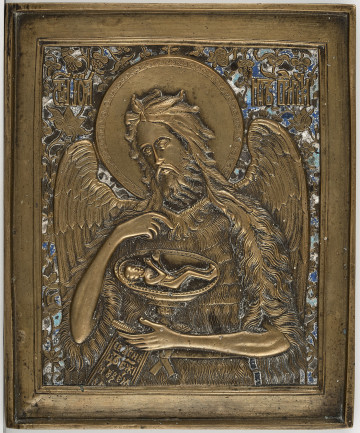
St. John the Baptist
20th century
Castle Museum in Łańcut
Part of the collection: Icons
The legend of the seven sleeping saints of Ephesus originated as a reaction to the heresy denying the resurrection of bodies at the time of the Parousia, or the return of the Christ. In the 4th–5th centuries, in the Eastern Christianity, it was doubted whether a body, of which nothing remains after death, could come to life again. The question raised was: would only intact remains be resurrected? To counter the heresy, the story of the Seven Youths, who were killed during the reign of Trajan Decius in the 3rd century, was used. They were young aristocrats performing military service and they were Christians. They refused to sacrifice to pagan deities at the request of the emperor who had come to Ephesus, they hid in a cave and persisted in prayer. The emperor ordered the entrance to the cave to be walled up, condemning them to certain death. According to legend, the Youths did not die but fell asleep and were awoken after nearly two hundred years when the entrance to the cave was accidentally uncovered during construction work. They did not realise how much time had passed, they sent one of them to buy some bread, and when the one in question wanted to pay with coins bearing the likeness of Trajan, he was suspected of hiding the treasure and led by force to the local administrator. Explaining his innocence, he led the people of Ephesus to the cave. The local bishop understood that by awakening the Saints after such a long time, God was pointing to the mystery of the Resurrection of Christ in order to strengthen faith in the resurrection of the body. The story of the Seven Saints from Ephesus reached Russia in the 12th century through the Hegumen Daniil, who, describing his pilgrimage to the Holy Land, quoted the apocryphal story of the Sleeping Youths. In the Russian Orthodox Church, they are praised on August 17 and November 4 (August 4 and October 22 according to the Julian calendar). In the Eastern Christian tradition, the Sleeping Youths of Ephesus are revered as helpers in insomnia, and their images usually appear in small and fine art, such as the featured icon. Teresa Bagińska-Żurawska https://orcid.org/0000-0002-9243-3967
Other names
The Seven Sleepers of Ephesus
Dimensions
height: 11 cm, width: 8.8 cm
Object type
Icons
Technique
gilding, tempera
Material
gold, tempera, wood
Origin / acquisition method
decyzja administracyjna
Creation time / dating
Creation / finding place
Owner
Castle Museum in Łańcut
Identification number
Location / status

20th century
Castle Museum in Łańcut

19th (?) century
Castle Museum in Łańcut

1800 — 1850
Castle Museum in Łańcut
DISCOVER this TOPIC
Castle Museum in Łańcut
DISCOVER this PATH
Educational path